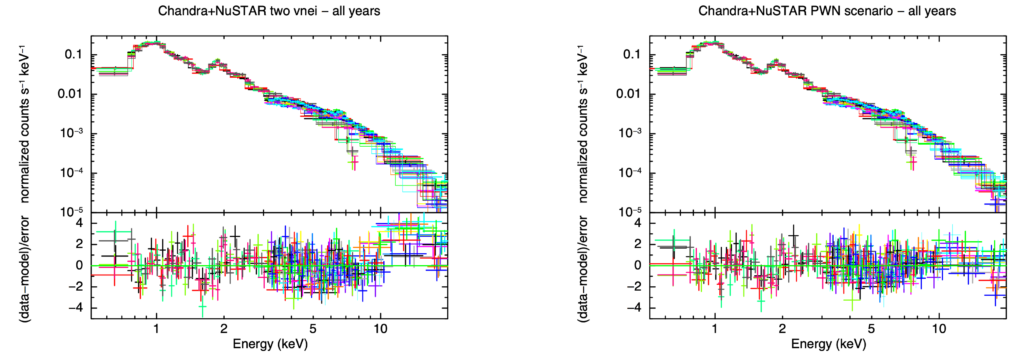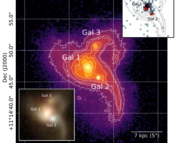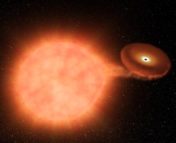Title: Indication of a Pulsar Wind Nebula in the hard X-ray emission from SN 1987A
Authors: Emanuele Greco, Marco Miceli, Salvatore Orlando, Barbara Olmi, Fabrizio Bocchino, Shigehiro Nagataki, Masaomi Ono, Akira Dohi, Giovanni Peres
First Author’s Institution: Università degli Studi di Palermo, Dipartimento di Fisica e Chimica, Piazza del Parlamento 1, 90134 Palermo, Italy
Status: Accepted for publication in ApJ Letters
In 1987 astronomers witnessed the closest supernova in almost 400 years, subsequently called SN 1987A. At only 51.4 kilo-parsecs (or about 167,000 light years), SN 1987A’s home is in the Large Magellanic Cloud, and was visible in the Southern Hemisphere with the naked eye for a few months before it faded. But one question that remains unanswered is what kind of object was left behind. The original star that created SN 1987A was a blue supergiant, which would have left behind either a black hole or a neutron star. Yet even with decades of observations by many telescopes spanning the electromagnetic spectrum, its nature has yet to be confirmed.
Why are astronomers still trying to figure out what was left behind in SN 1987A? One reason is that it would let us learn more about neutron star and black hole formation and the mechanics of supernovae. Another reason is that if this leftover object happens to be a pulsar, a neutron star that emits radio (and potentially X-ray or gamma-ray) pulses, then we would be able to observe its very early, formational years, which we know very little about. Recent work (like that discussed in this astrobite) suggests that a neutron star is the likely remnant, but can’t say for sure. The authors of today’s paper attempt to confirm once and for all that the leftover remnant of SN 1987A is a neutron star.
Look with your X-ray eyes
To determine the nature of the object at the center of SN 1987A, the authors use X-ray observations taken between 2012 and 2014 from the Chandra X-ray Observatory, which observes X-ray photons between 0.1 and 10 keV (this is the unit of energy kilo-electronvolts), and NuSTAR X-ray telescope, which observes X-ray photons between 3 and 79 keV (though the full range of each telescope is not necessarily used in the analysis). The images of SN 1987A from these telescopes are shown in Figure 1, with redder colors representing more photons detected.

The authors then analyzed the X-ray spectra, or number of photons observed at each energy, of SN 1987A between 0.5 and 20 keV, shown in Figure 2. By fitting different models to these spectra, they can determine what the source of the X-ray emission might be. The authors tested two primary models. The first one models the X-ray emission with two thermal components, each caused by high-energy Bremsstrahlung radiation. These components are essentially caused by two groups of highly energetic particles (usually electrons) that can each be described by a characteristic temperature, and are high enough energy to emit X-rays.
The second model is the same as the first, but it also includes a model for a highly absorbed pulsar wind nebula (PWN). PWNs are astronomical winds of charged particles accelerating close to the speed of light around a pulsar, and are known to give off high energy X-rays. Being highly absorbed means that very few of the X-rays emitted by the PWN are escaping the gas and dust that make up the supernova remnant of SN 1987A, and most are getting reabsorbed instead. The authors compute the residuals by subtracting these best-fit models from the X-ray spectra, shown in the bottom panels of Figure 2. The closer these residuals are to zero, the better the model. If this second model fits much better than the first, then the authors can say that there is very likely a PWN, and hence a neutron star, at the center of SN 1987A.

So what’s at the center?
Unfortunately the authors were unable to conclusively answer that question. They found that the model that includes a PWN is statistically slightly better than the one without (shown by the better residuals in in Figure 2 at energies > 10 keV), but not so much that they can say anything definitively. They were able to come up with a way that the higher energy X-rays might be produced without a PWN, but it involves an extremely energetic shockwave expanding steadily outwards at the fastest speeds allowed with no slowing down. While this is possible, it is an unlikely physical scenario compared to just having a neutron star at the center of SN 1987A.
Despite the uncertainty still surrounding the central object of SN 1987A, all is not lost! The authors also did some simulations showing that, if there really is a PWN at the center of SN 1987A, by the 2030s, less of the lower energy X-rays will be absorbed, and it may be easily detectable with Chandra or potential future X-ray observatories. So while the nature of what SN 1987A left behind remains a mystery for now, we are getting increasingly closer to solving it.
Astrobite edited by: Anthony Maue
Featured image credit: NASA, ESA, and A. Angelich (NRAO/AUI/NSF); Hubble credit: NASA, ESA, and R. Kirshner (Harvard-Smithsonian Center for Astrophysics and Gordon and Betty Moore Foundation) Chandra credit: NASA/CXC/Penn State/K. Frank et al.; ALMA credit: ALMA (ESO/NAOJ/NRAO) and R. Indebetouw (NRAO/AUI/NSF)





Hi Brent. I would add one small correction to your story. While SN 1987A was the nearest SN visible to us on Earth within 400 yr, it was not likely the closest within that period. The estimated supernova rate in our Galaxy is about 1 per 50 yr (see for example Calura et al. (2010, MNRAS 406, 1985 and references therein). Most of those should be within about 30 kpc of us. Of course most supernovae occur in the Galactic disk and are obscured from our view at most wavelengths.